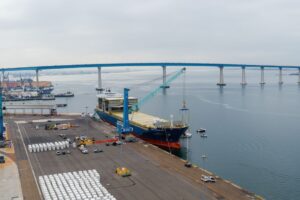Located along major shipping lines traversing the Red Sea and Gulf of Aden, the Port of Djibouti is a thriving shipping and logistics hub, delivering essential transhipment and cargo services. Thanks to its ideal location along many key international shipping routes, the Port is a valuable gateway to African markets, facilitating vital cargo and maritime services. These services have helped the port bring significant economic development to Djibouti, as well as its neighbouring countries, which rely on the port for trade. However, one of the most important roles of the Port of Djibouti is in supporting the trade of landlocked Ethiopia, which relies heavily on the Port to provide vital marine services to support the country’s import and export markets. With economies such as Ethiopia’s relying on the Port’s operations, the Port of Djibouti is continually focused on undertaking key development projects to help enhance the capability of the port, and allow it to continue to greatly serve the global trade operations it carries out for many years to come.
Check out the article in the magazine below:
The Port of Djibouti encompasses 7 specialised facilities to deliver it as a major logistics hub for global trade. This 7-facility network is a rare model used in Africa, but allows the port to deliver focused logistics, transportation and trans-shipment services across East Africa. The Port is overseen by the Djibouti Ports and Free Zones Authority (DPFZA), a governmental entity that manages the administration, directives, and operations of Djibouti’s ports, free zones and special economic zones, as well as many of the port’s main infrastructures. Thus, DPFZA’s mission is to establish the Port of Djibouti as a trade and transportation hub for Africa, taking advantage of its strategic location at the centre of two of the world’s busiest shipping routes to connect markets in Africa with customers across Asia, Europe and America. Therefore, a key part of DPFZA’s role is to strengthen Djibouti’s role as a logistics and infrastructure hub through projects that can enhance the port and deliver the economic potential of Africa.
Ethiopia is one of the most significant countries to the port, as the Port of Djibouti is responsible for handling around 90% of Ethiopia’s trade in goods, which it moves to and from Addis Ababa in Ethiopia, by either truck or rail. Therefore, Ethiopia plays a key role in the development of the port. Djibouti only has a population of around 1.18 million, and so the bulk of the port’s facilities have been built to take advantage of its position as a vital gateway to Ethiopia, Africa’s second most populous country. Thus, Ethiopia has helped to finance the construction and development of modern facilities at the port and deliver it as a key trans-shipment hub for other ports in the region. This has helped to enhance the Port of Djibouti’s network and deliver it as a major logistics hub, integrated into other transportation infrastructure to serve the East African region.
Across the Port of Djibouti’s 7 facilities is the Doraleh Multi-Purpose Port, located just 5km west of the city of Djibouti. The multipurpose port handles a range of cargo varieties, with the main commodities including oil, bulk cargo, containers and livestock. The port has the capacity to accommodate large vessels thanks to its deep-water berths. These berths mean that even large container vessels can arrive at the port, where cargo is then handled via modern equipment across several specialised terminals, which ensure the efficient management of different cargo types. The technical advancement at DMP is what has helped deliver it as an attractive destination along global shipping lines, ideal for customers seeking efficiency, reliable and seamless maritime logistics operations. Annually, the port has the capacity to handle 8.2 million tons of cargo. The Doraleh Multi-Purpose Port terminal then links to the Addis Ababa-Djibouti Railway, which provides essential transportation needed to move cargo from the Port of Djibouti and to landlocked markets in Ethiopia.
Another key facility of the Port of Djibouti complex is the Port of Tadjourah, which was primarily built to support potash export, but now serves as a key multipurpose port for the region. The port is capable of handling up to 2,000 tonnes of potash per hour, accumulating to 4 million tonnes per year. Across its infrastructure, the port has 2 linear quays of 455m in length and 12-15m draft (enabling it to accommodate 65,000 deadweight tonnage (DWT) general cargo vessels), as well as a roll-on/roll-off terminal with a 190m quay and 12m of draft. To help deliver commodities from the port across the region, the Port of Tadjourah was developed in conjunction with other major infrastructure works, including the North Tadjourah-Bahlo corridor highway, providing an even more seamless network to move cargo from the port and onto end markets.
One of the most valuable infrastructures connecting to the Port of Djibouti is the Addis Ababa-Djibouti Railway line. The railway was the first cross-border electrified railway of its kind in Africa, and today provides 753km of single-track standard gauge connecting Ethiopia’s capital with the operations at the Port of Djibouti. In total, 45 stations span the rail line, and it serves as the central transport corridor to Ethiopia, passing through the cities of Adama and Dire Dawa. The railway is owned by Ethio-Djibouti Railway (EDR) and was constructed by the Chinese state-owned companies of China Railway Engineering Corporation (CREC) and China Civil Engineering Construction Corporation (CCECC), who operated the railway for the first 6 years following the completion of its construction.
However, the management was transferred to EDR in May 2024, which is owned by the Government of Ethiopia (75%) and the Government of Djibouti (25%). The railway is vital to the Port of Djibouti, as between 2018 and 2024, the line carried 9.5 million tons of freight and 680,000 passengers. Thus, the rail network and the Port of Djibouti work closely together to deliver vital cargoes both in and out of Africa, which brings vital economic growth for the local economies involved, whilst delivering the port into a hub for maritime trade where business development remains at the heart of the port’s infrastructure.
As the Port of Djibouti looks towards the future, it is set on enhancing its network through a range of mega projects which will enhance the Port’s infrastructure and deliver the port as a hub for logistics and trans-shipment along the African coastline. A key example of this was outlined in 2024, when the port completed a USD 70 million expansion of the Doraleh Container Terminal. This expansion allowed the port to accommodate the largest container ships traversing international waters, whilst adding 4 additional high-capacity gantry cranes. This development has helped the Port of Djibouti to position itself as a key trans-shipment hub servicing some of the largest vessels in the world, bringing key revenue and benefits to clients in both Djibouti and Ethiopia.
Overall, the Port of Djibouti provides a unique yet vital infrastructure where logistics and port services meet to deliver cargo across the globe. As we have seen, Ethiopia’s trade relies heavily on the network of the Port of Djibouti to efficiently deliver cargo to and from the country and support its growing economy in the process. We look forward to seeing how the port continues to expand its infrastructure, alongside its transportation networks, to bring continued economic benefits to those across Djibouti, Ethiopia and the surrounding region.








